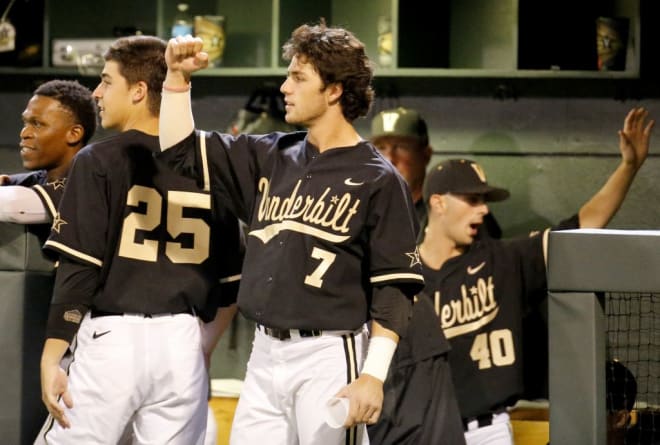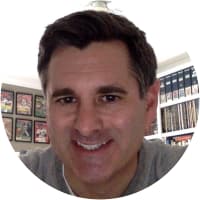The VandyBoys' All-Decade team: the starting infield and DH
Here's the starting infield for the VandyBoys' All-Decade team, according to Chris Lee, Chris Mahaffey and New York Dore.
"RC/27" is an estimate of how many runs a player creates for his team per 27 outs.

Catcher
The candidates: Andrew Giobbi, Curt Casali, Spencer Navin, Jason Delay, Karl Ellison, Stephen Scott, Philip Clarke
Chris Lee's pick: Spencer Navin
This was my toughest lineup pick, and actually went back and forth between Navin and my No. 2 choice (whom I'll reveal with my reserves) several times.
Navin caught full-time for two years, and was regarded as an outstanding defensive catcher. He threw out 20 of 39 runners in his first season as a full-time catcher (2012) and 16 of 43 the next season while fielding .980 and .993 those two seasons.
Navin wasn't a flashy offensive player, but posted on-base marks of .430 and .427 over those two seasons.
Chris Mahaffey: Spencer Navin
Vandy's had had some catchers with better numbers offensively and some that have done a slightly better job throwing out runners but Navin’s overall blend of offense and defense gives him the edge.
New York Dore: Spencer Navin
Navin was not only a top-three defender in the Corbin era, but also a surprisingly efficient and effective offensive tool, posting the two best ARC/27 years (8.33 in ‘13 and 7.84 in ‘12) among the catchers I considered (which did not include Stephen Scott).
Navin also guided Vanderbilt with the worst team of the decade (2012) and arguably the best (2013, although I’m in the minority on that opinion). Perhaps his best work was in managing a highly-inexperienced 2012 pitching staff.
Ultimately, Navin’s defensive prowess and offensive consistency allow him to sneak past Curt Casali for this starting nod.
First base
The candidates: Aaron Westlake, Conrad Gregor, Zander Wiel, Kyle Smith, Julian Infante
Chris Lee's pick: Aaron Westlake
Westlake was the quintessential power-hitting first baseman, smashing 42 home runs, eclipsing a .400 on-base mark in three years as a starter, and hitting .344.,463/.640 as a senior. Adjusted for run-scoring environment, that was the fifth-best offensive season in the Tim Corbin era. That's also the year when he hit three home runs to get Vanderbilt past Oregon State in Game 2 of the Nashville Super Regional and into Omaha for the first time. (video below)
Westlake had two other respectable offensive seasons. He also played a fair first base, with a specialty of using his long frame to dig throws out of the dirt.
Chris Mahaffey: Aaron Westlake
A great run producer with the kind of natural power you like to have at a corner infield position. A patient hitter who will take a walk and makes good contact, and a more-than-capable defender at first.
New York Dore: Conrad Gregor
To me, the hardest decision and one that I’ve flip-flopped on. While Aaron Westlake had one of the best seasons in VU history in 2011, I’m going to go with the athleticism and consistency of his successor: Conrad Gregor.
Gregor lacked the power production of Westlake, but did so in the depths of BBCOR hell. He was athletic, nimble and darn near impossible to strike out, while also working walk after walk. He lacks the power and intimidating frame of Westy, but ultimately provides the best overall value with ARC/27 seasons of 9.95, 9.76 and 8.87.
Second base
The candidates: Anthony Gomez, Riley Reynolds, Tony Kemp, Dansby Swanson, Tyler Campbell, Ethan Paul, Harrison Ray
Chris Lee's pick: Tony Kemp
Kemp was one of the easier picks on this team; it was just a matter of where.
Kemp played more in the outfield at VU, but slotting him at second--where he switched, in season, in 2013, with spectacular results--helps get a better team on the field. Kemp hit .391/.471/.485 in earning Southeastern Conference Player of the Year honors for the Commodores historic squad, which went 26-3 in the league that year, a record that will probably never be broken.
For his career, Kemp hit .329/.434/.432, stole 72 bases, walked more than he struck out (111 to 106), was universally loved by everyone and did his share to keep the locker room loose at Vandy.
Chris Mahaffey: Tony Kemp
I choose to place Kemp at the position that he played while winning the 2013 SEC POTY and nearly hitting .400. Kemp was awarded the 2014 MiLB Gold Glove at second and has an established record of making of highlight-reel plays. He is an elite athlete who would match perfectly with Swanson up the middle.
He's a top-of-the order bat that will get things started offensively and uses his great speed to constantly put pressure on the defense.
New York Dore: Tony Kemp
Tony! Toni! Tone! He may not sing as well as he swiped.
Tony Kemp was the most exciting and popular player to don the Black and Gold and for good reason. While he succumbed to a sophomore slump in the doldrums of the 2012 season, he sandwiched that with SEC Freshman of the Year and Player of the Year campaigns.
While some might want to put him in left, his max value position here is at second. That was best realized with his whopping 10.74 ARC/27 for the ‘13 juggernaut.
Shortstop
The candidates: Brian Harris, Anthony Gomez, Vince Conde, Dansby Swanson, Onnor Kaiser, Ethan Paul
Chris Lee's pick: Dansby Swanson
If there's a face of the program across the Corbin era, it's either Swanson or David Price.
Swanson was the second baseman on the 2014 national title team, not because he couldn't play short, but because Vince Conde felt more comfortable at short, and that allowed the Commodores to field a better team with both on the field.
Swanson transitioned to short for the national runners-up the next season and catapulted himself to the No. 1 overall pick for the MLB Draft that followed. He made two of the defining plays of that season, the first, breaking a 4-all tie with a ninth-inning home run against Indiana in VU's second game of the 2015 Nashville Regional and the second, robbing an Indiana hitter of a single with this play.
Swanson missed most of his freshman season with an injury, but hit .330/.418/.541 in his career. He fielded .974 with just eight errors in 71 games and had a hand in 44 double plays that season (and also turned that many at second as a sophomore.)
Chris Mahaffey: Dansby Swanson
Offensively he is the best shortstop to have played for Corbin and his defense is just a tick below the best. Great athleticism and speed also allow for him to swing to other positions if needed. Exemplary teammate.
New York Dore: Dansby Swanson
For as clear cut as Kemp’s selection was, "Dans" is even more obvious.
While Vanderbilt has had excellent defensive shortstop with offensive merit, to boot, Swanson produced the best offensive season of the decade at short (10.86 ARC/27) in ‘15, while also adding a strong offensive campaign (9.67) at second in the championship ‘14 campaign.
Third base
The candidates: Jason Esposito, Vince Conde, Xavier Turner, Will Toffey, Jayson Gonzalez, Austin Martin
Chris Lee's choice: Austin Martin
The ultimate jack-of-all-trades player lands here, where he excelled enough defensively to win the SEC's Gold Glove as a sophomore. Martin may leave Vanderbilt as its best hitter ever: he's hit .376/.479/.521 after a 2019 during which his offensive season, adjusted for run-scoring environment, is the third-best since Corbin's been at VU.
Martin has also come up big on the big stage, hitting two home runs off Louisville's Reid Detmers in VU's College World Series opener. The game before, Martin had two home runs in the first two innings as Vandy beat Duke, 13-2, to win the Nashville Super Regional.
Chris Mahaffey: Austin Martin
This was a difficult decision since there are several great candidates at the position. I choose to classify Martin as a third baseman since that is where he will have spent the majority of his Vanderbilt career. He walks more than he strikes out and is the unofficial “king of barrels.”
His offensive numbers are outstanding and he gives you positional versatility if the need arises.
New York Dore: Jason Esposito
Just as catcher and first were a question with no wrong answer when picking between the top two candidates, you couldn’t go wrong with Jason Esposito or Will Toffey.
Numerically, you were picking between consistency (Esposito’s 8.55 in ‘10 and 8.13 in ‘11) and a higher ceiling (Toffey had a monster 12.54 in ‘17, respectable 6.65 in ‘15 and a disastrous 5.94 in ‘14 that was saved by his steady walk rate).
In looking at defense, you were selecting between an outstanding defender (Toffey) and the second best defender of the Corbin era (Esposito, behind only Kaiser).
The determining factor for me ended up being Esposito’s 30 foot bat flip in walking off Louisville with a 17th inning homer.
(NOTE: New York Dore put Martin in left field.)
Designated hitter
The candidates: Any remaining hitter not picked for our starting eight
Chris Lee's pick: Conrad Gregor
Gregor was never much of a power hitter, but was remarkably consistent, with RC/27 o 9.4, 9.0 and 8.0 in his three seasons. Adjusted for run-scoring environment, those rank as the 11th, 15h and 21st-best offensive seasons of the decade. He hit .327/.444/.446 for his career, walking 127 times to 100 strikeouts.
Gregor was never regarded as much of a defender, but was adequate enough to hold the job the majority of 2012 and '13.
Chris Mahaffey: Will Toffey
In reality the DH would likely be based on matchups, especially with so many outstanding players on the bench. Toffey was the selection based on his production as compared to the other players not currently in the starting lineup. His plate discipline is in a league of its own (as evidenced by his advanced stats) and he can do damage when the pitch is in the zone.
New York Dore: Stephen Scott
In selecting the DH, you’re trying to put your best offensive weapon to complement the rest of your lineup. While Jeren Kendall had tools unmatched by any other Commodore, there was no batter I wanted at the plate in June more than Stephen Scott.
Scott was the quintessential warm temperature hitter, closing ‘18 with a prodigious streak (9.92 ARC27) and backstopping Bleday throughout ‘19 (10.88). His summer ball performances were even better than that.
But for some bad injury luck, his whole career could have been more akin to Spencer Torkelson than a kid who plays a fourth year of NCAA ball (but earns a ring for it).
I’m going to regret not having Kendall in my starting lineup, but with defense out of the equation, I’ll take the efficiency, power potential and playoff hitting of the Fire Hydrant.
